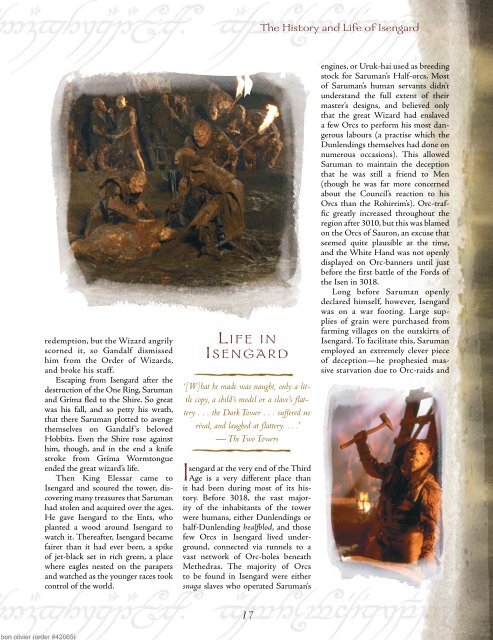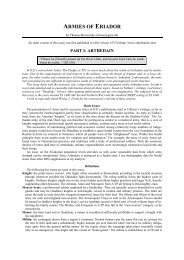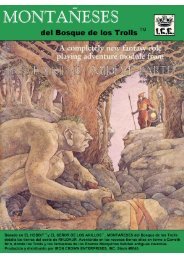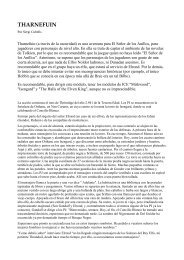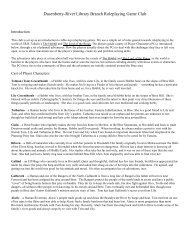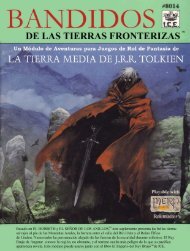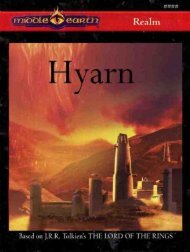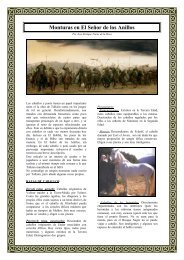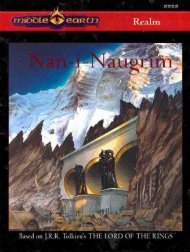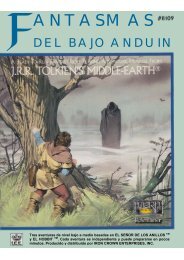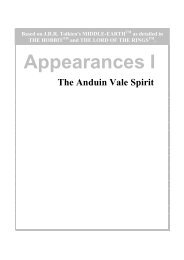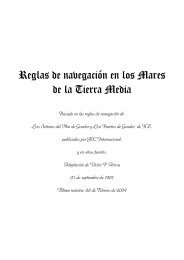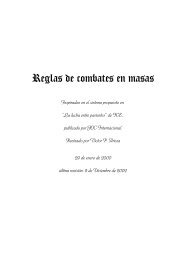bon olivier (order #42065) 83.114.187.4 - Fan Modules - Free
bon olivier (order #42065) 83.114.187.4 - Fan Modules - Free
bon olivier (order #42065) 83.114.187.4 - Fan Modules - Free
You also want an ePaper? Increase the reach of your titles
YUMPU automatically turns print PDFs into web optimized ePapers that Google loves.
edemption, but the Wizard angrily<br />
scorned it, so Gandalf dismissed<br />
him from the Order of Wizards,<br />
and broke his staff.<br />
Escaping from Isengard after the<br />
destruction of the One Ring, Saruman<br />
and Gríma fled to the Shire. So great<br />
was his fall, and so petty his wrath,<br />
that there Saruman plotted to avenge<br />
themselves on Gandalf ’s beloved<br />
Hobbits. Even the Shire rose against<br />
him, though, and in the end a knife<br />
stroke from Gríma Wormtongue<br />
ended the great wizard’s life.<br />
Then King Elessar came to<br />
Isengard and scoured the tower, discovering<br />
many treasures that Saruman<br />
had stolen and acquired over the ages.<br />
He gave Isengard to the Ents, who<br />
planted a wood around Isengard to<br />
watch it. Thereafter, Isengard became<br />
fairer than it had ever been, a spike<br />
of jet-black set in rich green, a place<br />
where eagles nested on the parapets<br />
and watched as the younger races took<br />
control of the world.<br />
l i f e i n<br />
i s e n g a r d<br />
‘[W]hat he made was naught, only a little<br />
copy, a child’s model or a slave’s flattery<br />
. . . the Dark Tower . . . suffered no<br />
rival, and laughed at flattery. . . .’<br />
— The Two Towers<br />
Isengard at the very end of the Third<br />
Age is a very different place than<br />
it had been during most of its history.<br />
Before 3018, the vast majority<br />
of the inhabitants of the tower<br />
were humans, either Dunlendings or<br />
half-Dunlending healfblod, and those<br />
few Orcs in Isengard lived underground,<br />
connected via tunnels to a<br />
vast network of Orc-holes beneath<br />
Methedras. The majority of Orcs<br />
to be found in Isengard were either<br />
snaga slaves who operated Saruman’s<br />
1<br />
The History and Life of Isengard<br />
engines, or Uruk-hai used as breeding<br />
stock for Saruman’s Half-orcs. Most<br />
of Saruman’s human servants didn’t<br />
understand the full extent of their<br />
master’s designs, and believed only<br />
that the great Wizard had enslaved<br />
a few Orcs to perform his most dangerous<br />
labours (a practise which the<br />
Dunlendings themselves had done on<br />
numerous occasions). This allowed<br />
Saruman to maintain the deception<br />
that he was still a friend to Men<br />
(though he was far more concerned<br />
about the Council’s reaction to his<br />
Orcs than the Rohirrim’s). Orc-traffic<br />
greatly increased throughout the<br />
region after 3010, but this was blamed<br />
on the Orcs of Sauron, an excuse that<br />
seemed quite plausible at the time,<br />
and the White Hand was not openly<br />
displayed on Orc-banners until just<br />
before the first battle of the Fords of<br />
the Isen in 3018.<br />
Long before Saruman openly<br />
declared himself, however, Isengard<br />
was on a war footing. Large supplies<br />
of grain were purchased from<br />
farming villages on the outskirts of<br />
Isengard. To facilitate this, Saruman<br />
employed an extremely clever piece<br />
of deception—he prophesied massive<br />
starvation due to Orc-raids and<br />
<strong>bon</strong> <strong>olivier</strong> (<strong>order</strong> <strong>#42065</strong>) 8


